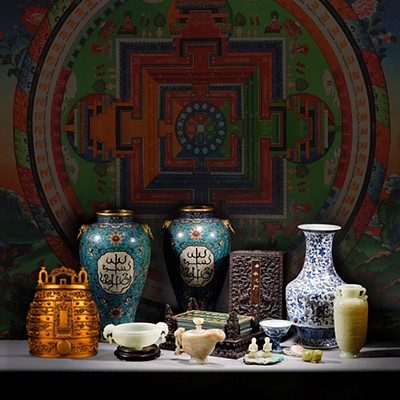A rare & important Xuande imperial bird feeder
About Seller
5091 Walnut Grove Ave
San Gabriel, CA 91776
United States
For over 30 years, Jumbo Auction House has been dedicated to curating collections of unique works of art for art lovers, decorators, novice collectors and fellow experts alike.
About Auction
Aug 10, 2022 - Aug 31, 2022
Jumbo Auction House is proud to bring you items of enticing Chinese works of art from private collection legacy, including important jade, bronze, cinnabar lacquer, paintings, jewelry, soapstone, snuff bottles, statues, porcelain vases, carvings, coins and much more! Jumbo Auction House jumboauction@yahoo.com
- Lot Description
This small porcelain bird feeder has almost all the important feature of Xuande (1426-1435 AD) porcelain. Its body is made of very fine but slightly off-white clay that was from Ma Chan Hill that forms hard/strong porcelain after firing, and was used for making early Ming imperial wares. The glaze, especially that on the inner wall, has a bluish-green tint and is milky, unique for Xuande porcelain. Due to 600 years aging the glaze has lost the surface shine. Interestingly, the glaze on the outer wall was applied by blowing mist of the glaze suspension in water onto the wall, but that on the inner wall by brushing on, so that it is somewhat uneven. The underglaze cobalt blue is very intense without rusty crust; this type of blue was imported from Samara (Middle-East) and used for making the best imperial Xuande wares. The brushwork is also unique; a finer and softer brush was used, as compared to that of Yuan period. As a result the strokes are finer and not cutting into the moist pre-fire clay body. But the strokes are still quite coarse comparing to that of Chenghua and later period, when finer and softer brushes were used to draw fine lines and to wash the blue to fill the space. The most unusual thing about this feeder is that it is fired in an up-side-down position. This firing technique was used by Ding Kiln of Northern Song more than 400 years earlier, and had not been used by major kilns since then. The mark is very typical for Xuande kai shu mark. Having this rare bird-feeder in your hand, you can learn many features of Xuande porcelain. Ming emperors fed caged birds, often in their study rooms, for enjoying their companionship and their singings. Bird-feeders were such an important group of wares of Xuande that a picture of a similar one is shown in Gen Bao Chan’s book, photo 84, p.48. From Dr. Robert I-San Lin (#3009), a senior Chinese artwork appraiser, whose grandfather was a major Chinese antique merchant in early 1900s. (Dr. Lin’s bio, in Journal of Authentication of Artworks, 2015, available). Brought to California in 1960s. 9.3 x 3.6 x 5.0 cm; 47.06 grams.NOTE: Any condition statement is given as a courtesy to a client, is only an opinion and should not be treated as a statement of fact. Jumbo Auction House shall have no responsibility for any error or omission. The absence of a condition statement does not imply that the lot is in perfect condition or completely free from wear and tear, imperfections, or the effects of aging. We do not carry out in-depth research of the sort carried out by professional historians and scholars, and any statements made by us orally or in writing about any lot concerning attribution to an artist, provenance, period, materials, origin, history, or dates represent an opinion of Jumbo Auction House and are not to be relied on as a statement of fact. Such opinions serve for informative purposes only and do not constitute historic or academic scholarship on the works and do not aim to substitute or contradict any such scholarship.
Condition
- Shipping Info
-
No property will be released until payment in full has cleared. Any expense related to packing, shipping and insurance (including reimbursement for damage or loss) of purchased lots is the responsibility of the buyer. Jumbo Auction House does not offer in-house shipping service for MOST items. Please arrange your own shipper to pick up the item(s) or we are happy to recommend shippers to you upon request. The emails of the two local shippers we recommend are on the invoice. Paid-for merchandise must be collected by the buyer or an authorized representative no later than forty-five (45) days following the date of the auction. Any merchandise remaining after this period will be subject to a storage fee of $10 per lot/per day. Please Note: Responsibility and all liability of items as well as safe delivery are assumed by carrier, shipper, buyer, agent or packing company upon acceptance of merchandise. Buyer will not hold Jumbo Auction House liable for any damage or loss after merchandise has been released from our possession.
-
- Payment & Auction Policies
-
Available payment options
-
-



 EUR
EUR CAD
CAD AUD
AUD GBP
GBP MXN
MXN HKD
HKD CNY
CNY MYR
MYR SEK
SEK SGD
SGD CHF
CHF THB
THB























